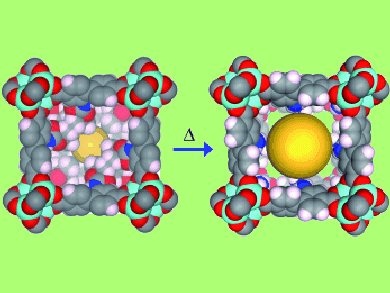In this issue’s Review by B. C. Tappan et al., read all about the synthesis of nanoporous metal foams: How can materials such as heterogeneous catalysts or high-surface conductors be produced? The Highlights deal with the use of Raman microscopy for the determination of the distribution of pharmacologically active metal carbonyls in cells and superhydrophobic flexible interfaces.
In the Communications section, G. M. Whitesides et al. present chemically based systems for non-electronic communication that can transmit alphanumeric information encoded as pulses of light, so-called infofuses, which can operate for hours. P. M. Blumberg et al. not only succeeded in the total synthesis of C9-deoxy bryostatin 1, but also in its molecular modeling and biological evaluation. S. G. Telfer et al. were able to synthesize an open, cubic metal-organic framework by using a bulky residue to suppress interpentetration – the picture illustrates the void created by the postsynthetic removal of the bulky group.




